The story of Dachau, as told to touristsThe International Monument & Unknown Prisoner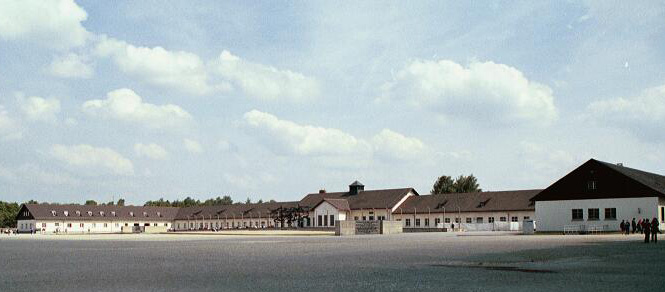 The International Monument at Dachau is made up of several separate parts, which were placed on a huge field of gravel in front of the former administration bulding, shown in the photo above. This is the place where morning and evening roll calls were held. It is the first thing that tourists see after they enter the gate into the former camp and they imagine the prisoners being forced to stand there for hours in all kinds of weather. The tourists are told by one of the guides that there was a "sick parade" each evening on the field of gravel, shown in the photo above, where the sick and the infirm were beaten and ridiculed. However, a former prisoner, Paul Berben, wrote extensively about the medical treatment available to the prisoners in his book "Dachau 1933 - 1945: The Official History." He described the modern medical equipment and an operating theater at Dachau where prisoners were treated by doctors who were prisoners in the camp and also by German doctors on the staff. Arthur Haulot, a prisoner in the camp, wrote in his dairy about how he was nursed back to health after he arrived at the camp seriously ill. On the west side of the International Monument, which is on the right in the photo above, is a wall whose inscription in English reads "May the example of those who were exterminated here between 1933 and 1945 because of their fight against National Socialism unite the living." On the east side of the field of gravel is a short wall with the inscription "Never Again" in five languages, as shown in the photo below. 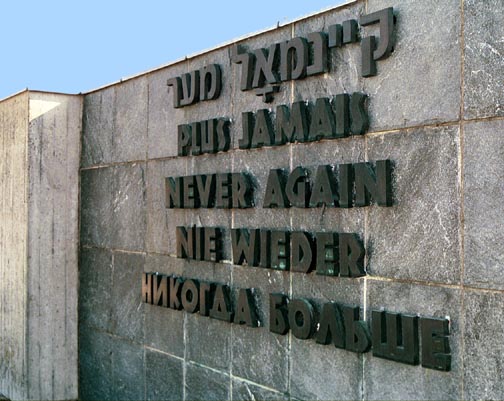 In the photograph below you can see the roof of the east wing of the administration building behind the short "Never Again" wall that is part of the International Monument. In front of the wall is a box of ashes of the victims of the Dachau concentration camp, which was placed here on May 7, 1967, the same day that the Jewish Memorial building was dedicated. These were ashes that were found in red clay urns in the crematorium building when Dachau was liberated. 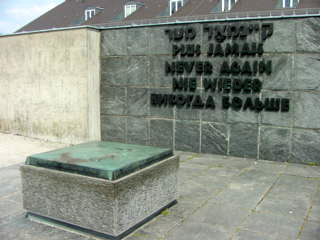  The photo above, taken on a gloomy day at Dachau, shows a sculputure that is part of the International Monument. The sculpture, which was designed by Nandor Glid, stands in front of the Dachau Museum; it was formally dedicated in September 1968. In the background of the photo, one of the two reconstructed barracks can be seen.  From below, you can see that the sculpture is not flat, but has a depth of about four feet. Notice the hands of the skeletons which resemble the barbs on a barbed wire fence. The sculpture is approximately 48 feet wide and 19 feet tall. It symbolizes the emaciated bodies of the prisoners who died of starvation and disease in the camp. The sculpture is made of dark bronze. It features short strands of barbed wire on which skeletons are hanging with their heads dangling sharply. On either side of the sculpture are concrete fence posts which closely resemble the ones actually used to support the barbed wire fence around the camp. Underneath the sculpture are the dates 1933 - 1945, the years that the camp was used as a concentration camp for anti-Nazis. 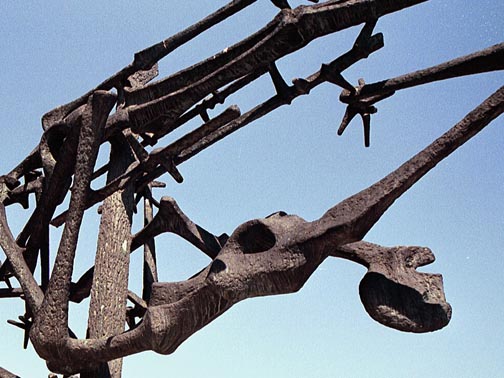 A competition among artists who were concentration camp survivors was announced on New Year's day in 1959 to find a suitable design. Forty-five of the 63 entries were exhibited in November 1959 at the Ministry for Health and Family in Brussels. The final decision to choose the entry by Nandor Glid was made by Albert Guérisse, who was imprisoned at Dachau after he was captured while working as a spy for the British SOE. Guérisse was the President of the International Committee which planned the Memorial Site. The International Monument includes the sculpture shown in the photo below.  The photo above shows a sculpture in front of the Museum building, which displays the triangles worn by the Dachau prisoners on their uniforms. Jews wore two triangles, one yellow and one red or blue. Red denoted a political prisoner and blue denoted a person brought from another country to perform forced labor. Non-Jewish Polish forced laborers at Dachau wore a blue triangle. 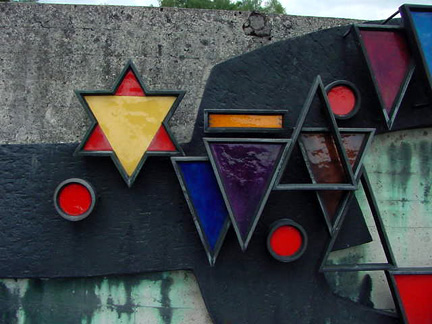 A bar over the triangle denoted a person who had been released and then incarcerated again for a second offense. A dot below the triangle meant that the prisoner was in the punishment detail and had to perform hard labor. The vast majority of the prisoners at Dachau were political prisoners from other countries, primarily Communists and illegal combatants who continued to fight after their countries were conquered; they wore a red triangle, pointing downward. A red triangle pointing upward was for a German political prisoner, but they are not included in this sculpture. German criminals wore a green triangle, but notice that they are not included either. The anti-socials and the "work-shy" wore a black triangle. The first Gypsies sent to the camp had been arrested because they were "work-shy" and they wore a black triangle. Later, the Gypsies were sent to camps in the East and they wore a brown triangle. Homosexuals wore a pink triangle and Jehovah's Witnesses wore a purple triangle. The first memorial to be put up at Dachau was the statue known as the "Unknown Inmate," by Fritz Koelle, which was erected in 1950 north of the old crematorium; it is shown in the photo below.  The words on the base of the statue, translated into English, mean "To honor the dead, to admonish the living." The model for the statue was Kurt Lange, who was a homosexual imprisoned at Dachau after he was arrested twice under Paragraph 175 of the German law and had served two sentences. Under a new Nazi law in 1937, all criminals who had served two prison terms were sent to a concentration camp for at least six months of "rehabilitation." A recent visitor wrote the following on her blog about what her tour guide said about the statue: This was the first memorial piece that was placed in the camp in 1950. The survivors don't like this because it shows him wearing a coat and shoes, neither of which they had. This is another example of the bavarian government trying to repress and re-write past. The statue of the Unknown inmate was erected by survivors of Dachau, not by the Bavarian government. The Bavarian government, which currently pays for the upkeep of the Memorial Site, is trying to keep the memory of the Dachau camp alive, not repress the facts or re-write the past. The photo above, taken after Dachau was liberated on April 29, 1945, shows Dachau inmates wearing overcoats that are better than the one on the statue. In the center of the photo, wearing a sweater vest under his overcoat, is Albert Guérisse, who was sent to Dachau after he was captured while fighting as an illegal combatant in violation of the Geneva Convention. Dachau MemorialsGas chamberDisinfection Chambers & OvensDachau Museum & BunkerRefugee Camp at DachauArbeit Macht Frei gateInternational Monument & Unknown PrisonerEntrance to Memorial SiteBack to Dachau Concentration CampBack to Table of ContentsHomeThis page was last updated on October 24, 2009 |